-

Annie Turner in her studio
Cavaliero Finn has worked with ceramicist Annie Turner for a number of years now after first encountering her incredibly beautiful ceramic sculptures at her open studio when she was based in Vanguard Court in Peckham. Working with Annie is quite special. Like her work, she is warm, earnest and sincere and wholly dedicated to her craft. Our appreciation of her and understanding of her work is enriched every time we talk to her. What astounds us the most is the sheer level of technical skill which she has acquired since her graduation in 1983 from the Royal College. As you’ll find out as you read this interview, creating the kind of work that Annie does work is no mean feat. She is a master craftswoman. So it was no surprise to Juliana and I that she was shortlisted in 2019 for the prestigious Loewe Craft Prize. Annie’s work along with 28 other international artists (including that of Akiko Hirai whose work Cavaliero Finn also exhibits regularly) was chosen by a panel of experts from over 2500 submissions and was part of a finalists exhibition in Tokyo.
We hope after reading this short interview with the artist that you too begin to share our passion for Annie’s work.
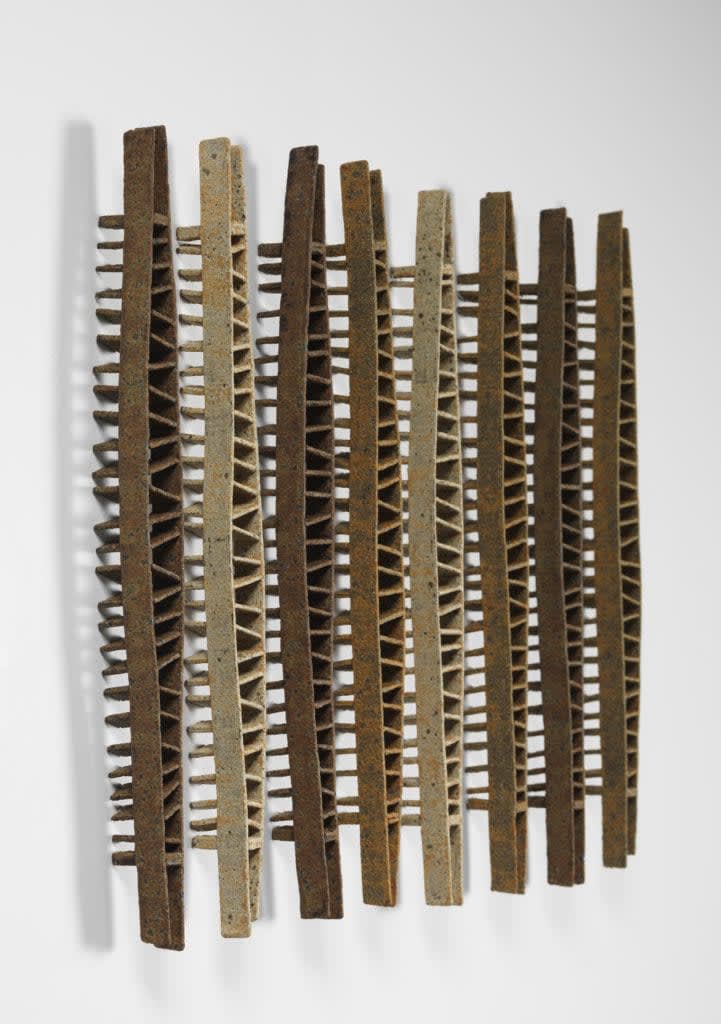
Wind Against Tide Sculpture, Wall hanging ceramic sculpture, Hand built textured stoneware,
8 individual pieces. Each piece approximately W 3 x L 38 x D 3.5 cm each.
CF: How did you become an artist Annie?
AT: From the age of about 8, perhaps a bit younger, I drew constantly, either stories from my imagination or drawing objects, plants and so on.
When I finished school I was lucky enough to be accepted onto the Foundation course at Ipswich, it was a wonderful course, in particular, Life Drawing taught by Colin Moss, he was a brilliant teacher. Each subject of the Arts was covered and I remember vividly my time spent in the pottery department. I didn’t choose Ceramics it chose me. There is no material quite like clay. This amorphous ‘wobbly’ stuff through mind and hand can be transformed into a multitude of forms, colours, and surfaces. I went on to study Ceramics at Bristol Polytechnic, sadly this course no longer exists; it was a fabulous experience and I was taught by Mo Jupp and Wally Keeler amongst others.
I went on to study Ceramics at The Royal College of Art. My personal Tutor was Eduardo Paolozzi, wow! He was an extraordinary man, a great artist, and a very generous teacher
River Deben, Sufolk

Swan’s Nest Sluice, Handbuilt stoneware, 13.5 cm (h)
CF: Your work has an intrinsic link to the River Deben and its surrounding landscape in Suffolk. Why does this region have such an impact on your work? Can you tell us a little more about this?
AT: I grew up in a small village called Waldringfield, which is on the banks of the River Deben in Suffolk. As a child, I remember long hot summers swimming, sailing, fishing, and hunting for fossils. In particular, sharks teeth and coprolite (fossilised dung) which always held a great fascination for me, as you can imagine. My cousins and I had complete freedom playing in and around the river; there was only one rule, life jackets had to be worn at all times. I spent a lot of time with my Father, I think perhaps I was the son he never had. We sailed and fished for herring using drift nets, usually late into the evening on a full moon. The sounds of the birds feeding and the phosphorescence in the water as the nets were picked up and hauled aboard was sheer magic, we both shared a real passion for the river, the acres of silent mudflats and meandering creeks. I have always wanted to make work about this landscape and my relationship to it. I started making simple objects, but it wasn’t until I read an article by Philip Rawson titled “Pot” “Body” and “Image” and in it he discussed the belief that ‘clay itself has a profound symbolic value’ and that ‘for anything to be symbolic implies that it is far more than what it objectively is’. This really connected with my thoughts and I began making spoons and ladles, a vehicle in which to encapsulate and instil the essence of the river as something nurturing and life-giving. The bowl of the spoon contained feathers, sharks teeth, and fragments collected on the foreshore, but also the containment of memories, places and my family too. The handles of the spoons referred to the Jetties which run along the marshes. From this point my work developed quickly, it was a very exciting time for me.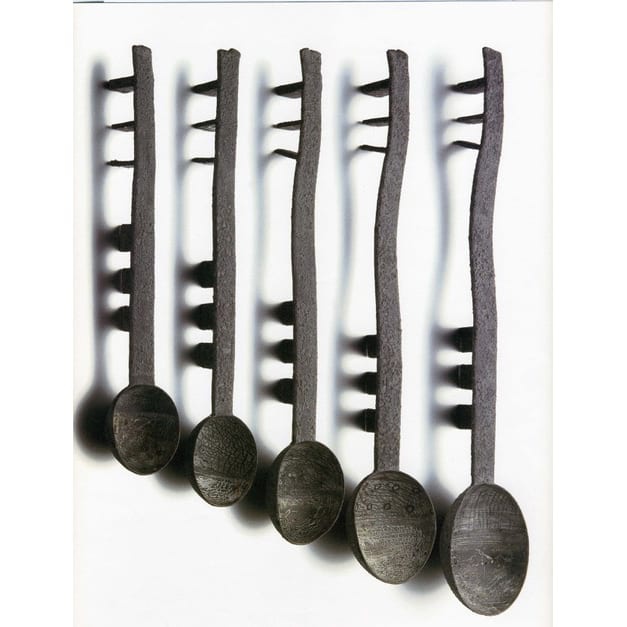
Foreshore Spoons, hand built stoneware by Annie Turner circa 2004
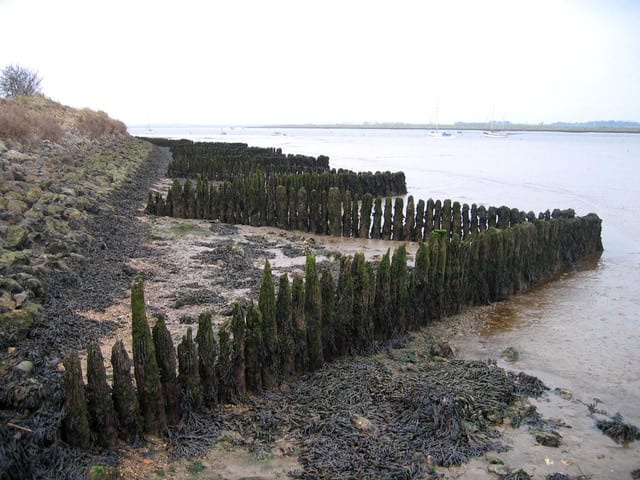
Along the river banks at the River Deben
CF: The work, particularly your grid like Drift Net sculptures, has an architectural feel? Is this intentional?
AT: Yes, there are architectural elements to the Drift Net sculptures, however, each piece holds several themes, they also suggest ladders that climb and jetties that cross, the sluices which pass through the river walls and the sinkers. When you walk through the marshes and along the river’s edge there are many wooden structures built a long time ago, evidence of a past industry. Perhaps structures to hold back the receding tide or to prevent the incoming tide. It’s said they were Oyster and Mussel beds nobody really knows. I see it as the river’s architecture, evidence of man’s intervention. The Mussel and Oyster beds have recently been relayed which is great. I love the idea that once again the River Deben is providing a source of income just as it once did.
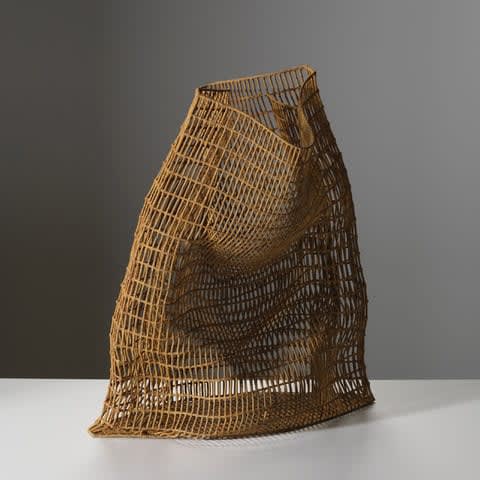
Drift Net, Hand-built stoneware, approx 60 x 48 x 25 cm

Where the River Deben meets the land
CF: Walk us through making one of your sculptures… what materials and techniques do you use?
AT: I start by drawing the base on canvas. I hand roll coils of clay, once they are leather hard I construct with the pre-cut vertical coils. When the joins are stiff, I lay the horizontal coils across the verticals. All the joins are then painted with slurry. As the form grows I have to pack the interior with polythene to prevent drying. The outside is wrapped with polythene at all times. When the sculpture is complete, and this is the scary bit, I have to remove all the plastic from the inside. The structure is built on a kiln shelf and before the structure dries too much it is transferred into the kiln where it is draped with a plastic sheet so it dries out very slowly.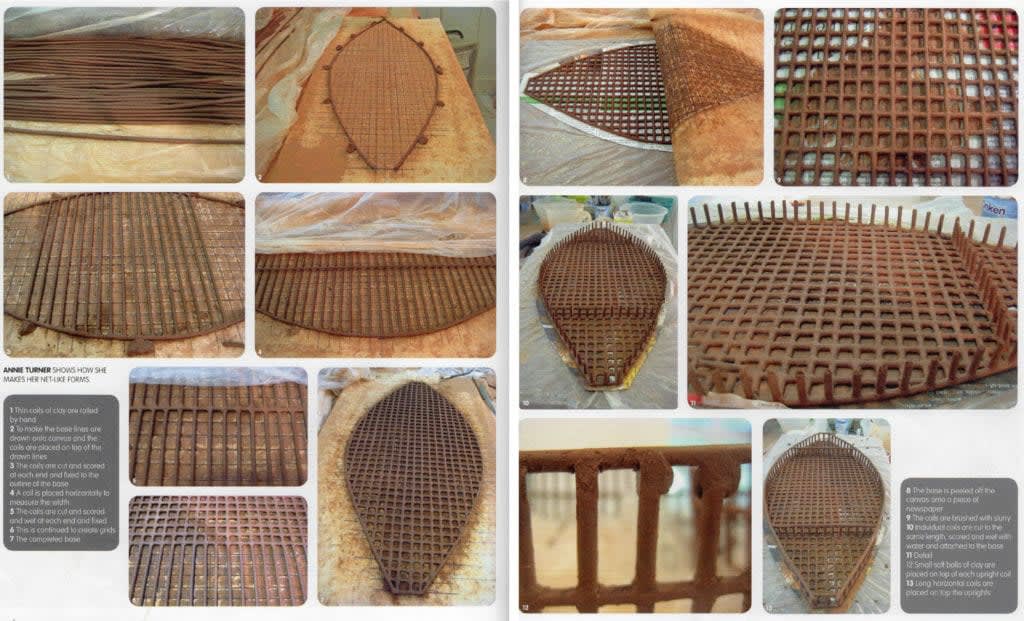
Makers Notes feature in Ceramic Review March/April 2015 Issue 272 walks you through the making process visually
CF: Unlike the work of many of our other artists, you use the kiln to encourage the bending and collapse of the forms you create. How do you engineer this and how much control is used by you as the artist operating the kiln and how much, if anything, is left to chance?
AT: Through trial and error really I have understood how to in build the weaknesses and strengths of the form so I can promote a lot of movement or very little. However, there have been surprises along the way one piece, in particular, is now in the Fitzwilliam Museum. I remember opening the kiln to a gasp! But once out of the kiln, well it was a eureka moment!! This doesn’t happen often and there will not be another like it. I do have disasters too which are always disappointing, but you pick yourself up and move on.
Studio Ceramics. Net. Annie Turner (British, b.1958).. Hand-built stoneware with lithium glaze, h 33 x w 50 x d 34 cm.
Given by Nicholas and Judith Goodison through the National Art Collections Fund.
CF: Your work is much sought after and collected worldwide. It can be seen in permanent museum collections including the Victoria and Albert Museum and the Fitzwilliam Museum in Cambridge and you were shortlisted for the Loewe Craft Prize 2019. How does this make you feel as an artist?
AT: Of course, I am delighted. I have many colleagues and friends who work with clay, we all work extremely hard. Having my work displayed alongside the likes of Gillian Lowndes amongst others is hugely gratifying. I just wish my parents were still alive to see it.
Keep Nets, hand built stoneware
CF: Which artists particularly inspire you and why?
AT: No artist in particular although I do love going to exhibitions. It’s poetry really, I love the economy of words and this is something that I try to achieve in my own work paring down the visual language. For me, less is more!
Claws, handbuilt stoneware, approximately 7 x 13 x 29 cm
CF: We love it when we are approached by past ceramic students of yours at our exhibitions. They are extremely passionate about your work and it is evident from speaking to them that you have a huge impact on everyone you have taught at City Lit. Do you feel this enriches your work and if so in what way?
AT: That’s very nice to hear. Teaching is always an enriching experience, it’s a privilege. I meet people from all walks of life and different parts of the world. When talking to students I often hear myself talking back to myself! A reminder of ‘things’ forgotten. Ceramics is such an expansive, complex subject. I often hear myself saying to students I DARE YOU! It gives them permission to fail, which of course they don’t.
Mussel Box and Sieve, handbuilt stoneware, approximately 15cm H
CF: Tell us one piece of advice you give aspiring ceramicists?
AT: You need dogged determination and passion. You need to take every opportunity to get your work seen and invest in professional photography when you can afford it.
Installation shot featuring a set of three ladders by Annie Turner, positioned alongside moon jar by fellow Loewe Craft Prize finalist, Akiko Hirai and paintings by Gill Rocca.
Works by Annie Turner